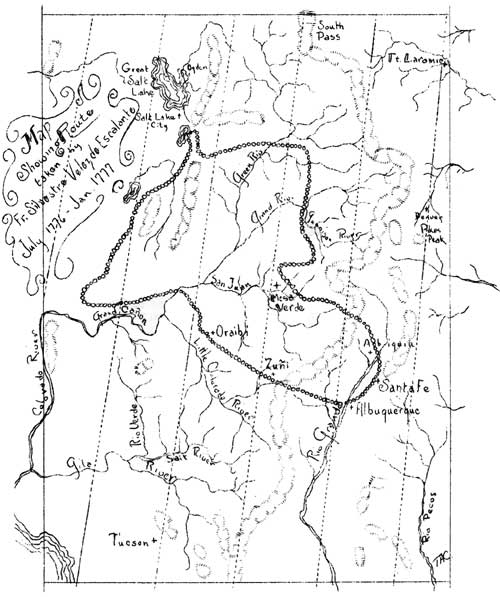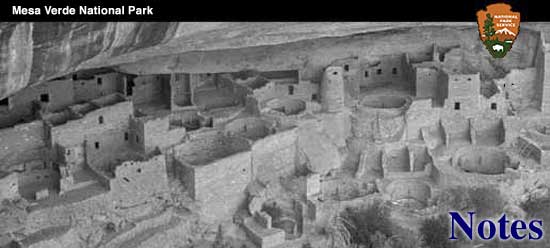IMPORTANT ANNIVERSARIES IN 1936
by
Paul R. Franke
The year 1936 marks the anniversary of a number of historical events
most important to the Southwest. These, in chronological order, may be
listed as: Escalante's journey from Santa Fe to the Great Salt Lake in
1776, the passing by Congress of the Antiquity Act in 1906, and the
Creation of Mesa Verde National Park in 1906.
It was on the 29th day of July in 1776 that Fray Francisco Atanasio
Dominquez and Fray Francisco Silvestre Velez de Escalante departed from
Sante Fe, the capitol of New Mexico, for the purpose of exploring the
land north and west hoping to discover a direct route to Monterey, in
Alta, California.
Fray Escalante, in his diary1, states that he made use of
the notes and diary of one Juan Maria de Rivera, who had covered the
route from Santa Fe to Fort Roubideoux in 1765. Rivera was therefore
no doubt the first white man to see the Mesa Verde, but as his diary has
never again been found by historians and we are unable to state how
close he really come to the great Plateau, we must, in the evidence of
recorded historical data confer that honor upon the expedition of Fray
Francisco Escalante.
1. Harris, W.R., The Catholic Church in Utah, Intermountain Catholic
Press, Salt Lake City, 1909, Pages 124-242.
The route of the expedition as shown on the accompanying map, closely
parallels the present highway north from Santa Fe through Abiquiu,
Pagosa Springs, thence westward through Durango and near the Mesa Verde.
To quote from his diary the paragraphs describing his camps in the
vicinity of the Mesa Verde:
"10th day of August, Father Fray Francisco Atanasio awoke with a
severe attack of rheumatism, which he had begun to feel the day before
in his face and head, and it was necessary to remain here until he was
relieved, the continued rain and dampness of the place, however, obliged
us to leave. Going north a little more than half a league we turned
northeast. A league farther on we turned to the west, through beautiful
mountain glens, full of verdure, roses and other flowers. Two leagues
farther on it began to rain copiously which caused Father Atanasio to
become much worse, and also made the road impassable. We passed on two
leagues farther west, but were obliged to stop by the first of the two
small streams which make up the San Lazaro, other called Las Mancos. The
pasturage continues to be abundant; Today, four and a half leagues.

(click on image for a PDF version)
"11th day of August. Notwithstanding the cold and dampness
from which we suffered, we were obliged to remain because Father
Atanasio was very much weakened from his suffering, and had some fever.
We were not able to visit the mines of the Sierras, although one of our
companions, who had visited them on a former occasion, assured us they
were but a short distance away.
"12th day of August. Father Atanasio awoke somewhat better, and, for
a change of place and temperature more than for the purpose of
continuing our journey, we left this location and the river of San
Lorenzo (Las Mancos) to the northeast, and after going a little more
than a league we turned to the west-northwest, and traveled five
leagues over green mountains with good pasturage. To the west for two
and a half leagues we passed through a piece of burnt-ever woodland with
scant pasturage, and turned to the north, crossing the Rio de Nuestra
Senora de los Dolores (River of our Lady of Sorrows), and halted on the
southern side of the Sierra de la Plata. This river flows south, and
during this season is much smaller than the northern river. Today a
little more than eight leagues.
"13th day of August. We made a stopping place here, so that the
Father might the sooner recover, and also that we might ascertain the
latitude of this location and the plain of the River Dolores in which we
find ourselves. We have taken observations and find we are in latitude
38 degrees 13-1/2 minutes. There is everything here requisite for
the establishment of a good town, the land only needing irrigation, with
pasturage, wood and timber. On the southwest bank of the river, on a
rise of ground, there appears to have been, anciently, a small town,
similar to these of the Indians of New Mexico, judging from the ruins
found here, which we carefully examined. Father Fray Francisco
Atanasio being very much better today, we decided to continue our
travels on the morrow."
Thus on the 14th day of August the expedition passed on to the north
and west. There can be no doubt from this description and a study of the
map that during the 10th, 11th, 12th, and 13th of August in 1776 this
expedition was in full view of the Mesa Verde. Its name is not used and
in those early years the archeological wonders in the southern canyons
were only noted in the legends of the Indians. The year 1936 therefore
marks the one hundred and sixtieth anniversary of the exploring
expedition of Fray Silvestre Velez do Escalante, the first white man to
describe the country adjacent on the north escarpment of the Mesa
Verde.
It was on June 8, 1906 that President Theodore Roosevelt signed an
act just previously passed by Congress, entitled "An act for the
preservation of American antiquities." This act was the result of
destructive exploration and vandalism in the magnificent ruins located
in the Mesa Verde and Chaco Canyon regions. The act provides among other
things:
"The any person who shall appropriate, excavate, injure, or
destroy any historic or prehistoric ruin or monument, or any
object of antiquity, situated on land owned or controlled by the Government
of the United States, without the permission of the Secretary of the
department of the Government having jurisdiction over the lands on which
said antiquities are situated, shall upon conviction, be fined in a sum
of not more then five hundred dollars or be imprisoned for a period of
not more than ninety days, or shall suffer both fine and imprisonment,
in the discretion of the court." Approved, June 8, 1906 (34 Stat. L.
225).
On June 8, 1936 appears the thirtieth anniversary of the passing
of this act and its influence and effect can be seen in the
archeological parks and monuments that were fathered by it.
Just twenty one days after the passing of "An act for the
preservation of American antiquities" the same congress created the Mesa Verde
National Park. This act of June 29, 1906 (34 Stat; 616), provided among
other things, "That the said public park shall be known as the Mesa
Verde National Park and shall be under the exclusive control of the
Secretary of the Interior," also; "that the examination & excavation
are undertaken only for the benefit of some reputable museum, university
or some other recognized scientific or educational institution, with a
view to increasing the knowledge of such objects and aiding the general
advancement of archeological science. The act also provides that
permission for scientific research be secured from the department and that
the people of the United States be not deprived of the free enjoyment of
the ruins.
A third anniversary then appears on June 29, 1936, to mark the
thirtieth year since the creation of the Mesa Verde as a National
Park.
A fourth event of major importance to mark a milestone in the
development of this park will occur during the next summer. This will be
the dedication of the new and enlarged museum which is now under
construction. This new addition has been made possible by funds
allocated to the Park by the Public Works Administration.
Thus to review, we hope to celebrate in 1936, by suitable programs
and lectures and pageants, four important events in Mesa Verde
History:
June 8, 1936 - The 30th Anniversary of the Antiquity Act.
June 29, 1936 - The 30th Anniversary of Mesa Verde as a
National Park.
August 10th, 1936 - The 160th anniversary of Escalante's exploring
expedition.
An un-named date in 1936 — The dedication of the enlarged
Mesa Verde Museum.
We hope that many of the friends and visitors of past years will
plan their next summers vacation to be with us during one of these
celebrations.


